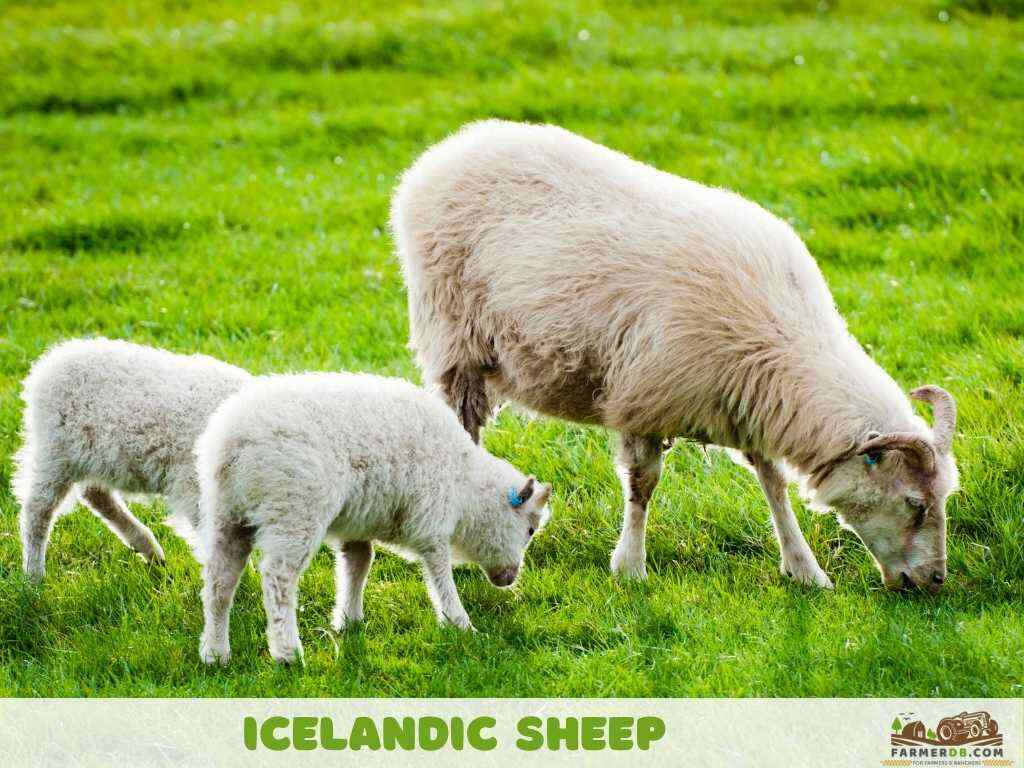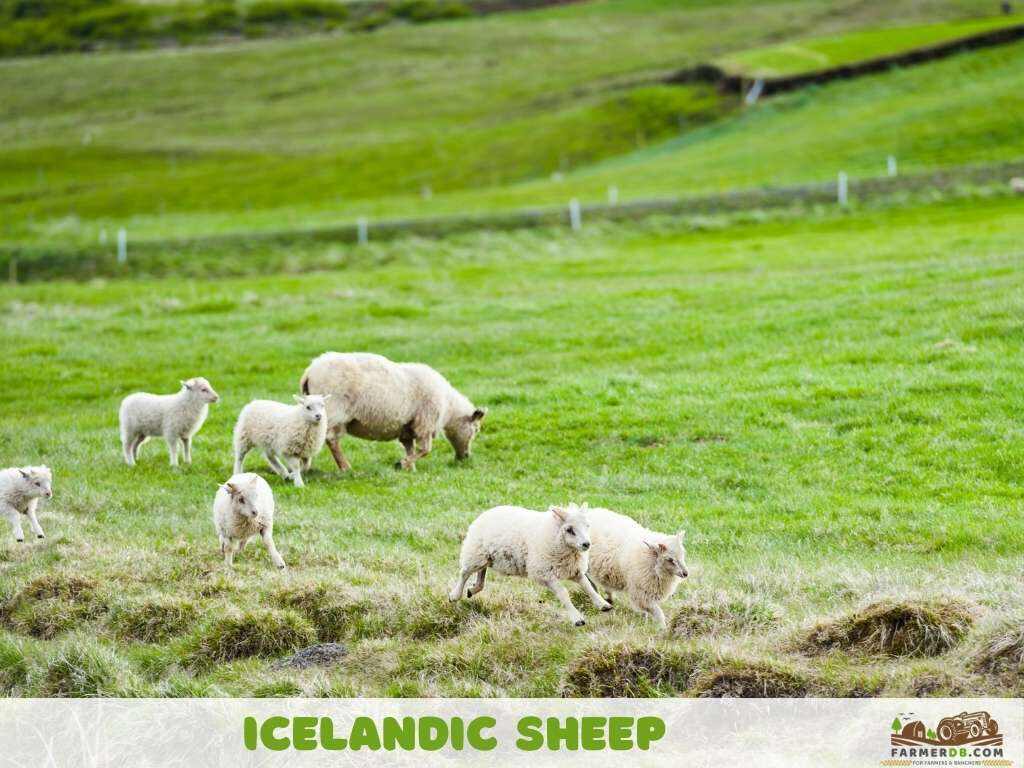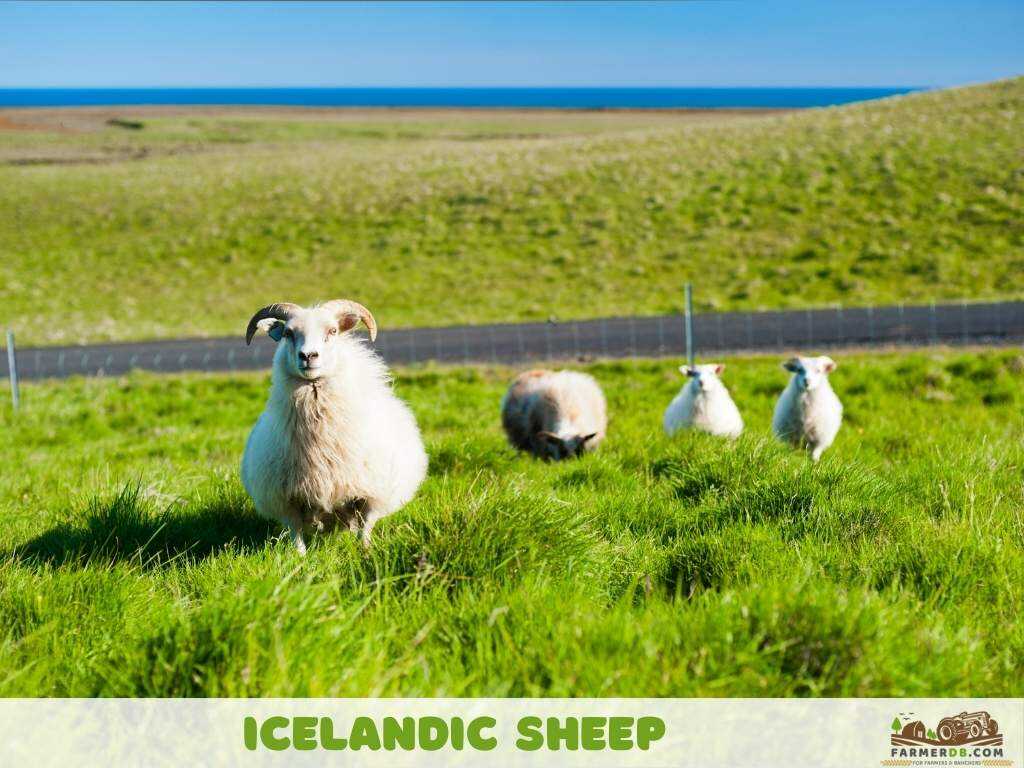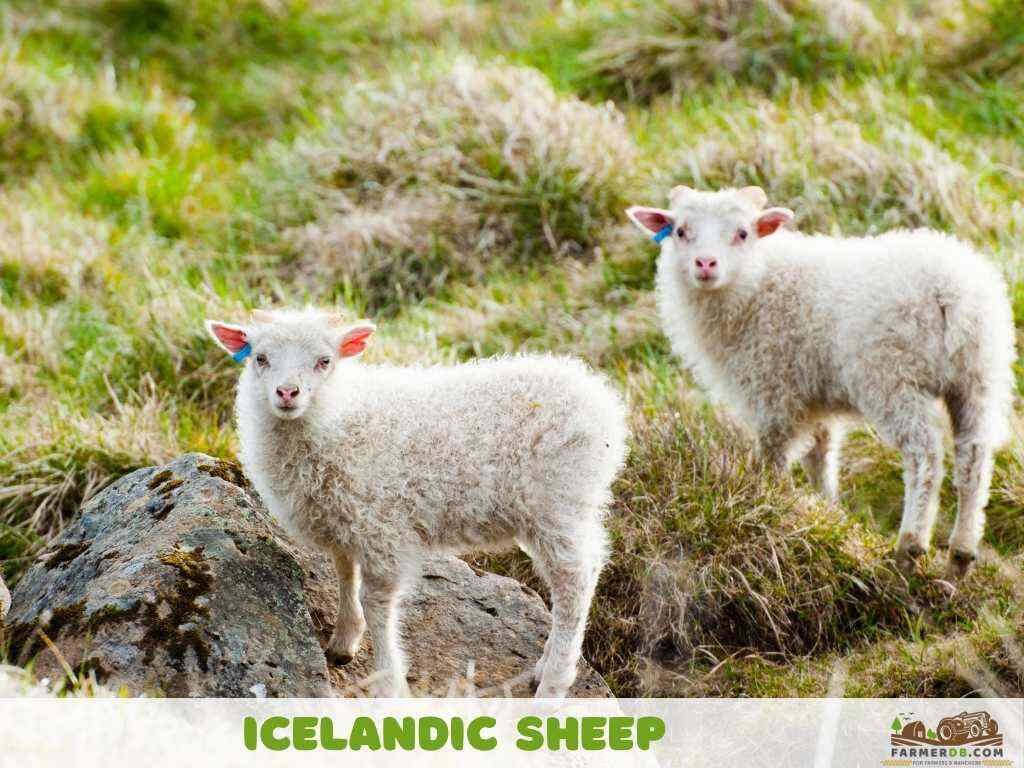The Icelandic sheep is a domestic, meat sheep breed belonging to the North European Short-Tailed type, alongside other breeds such as Finnsheep, Shetland, Romanov, Spelsau, and Swedish Landrace.
It is the largest among these medium-sized sheep.

Contents
Characteristics
Size
They have a medium size.
An adult sheep stands around 19 to 30 inches (48 to 76 cm ) at the shoulder and has a body length of 48 to 70 inches (122 to 178 cm) from the tip of the nose to the base of the tail.
Their body size is quite similar to that of the Romanov sheep. It’s important to note that measurements can vary among individual sheep due to factors such as gender, age, genetics, and diet.
Color
These sheep have various colors and patterns, ranging from white and black to brown or moorit.
Fleece
They are double-coated, meaning that they have two layers of coat: an outer coat, also called tog, and an inner coat named thel.
The thel plays an insulation role during adverse weather conditions, while the tog provides general protection.
The fleece comes in a wide variety of colors, ranging from white to black, gray, and different shades of brown as well. It extends over the body but does not extend to the head and legs.
Head, Ears, Face, Eyes
The head is well-proportioned to its body size.

The face is of medium size and is covered by a woolly fleece. The color of the face can vary along with the coat color. The forehead is broad, and the eyes are bright and expressive.
The ears are also medium-sized, erect, and mobile. The shape and positioning of the ears can vary somewhat among individuals.
Horns
Many sheep have horns, but some do not. The sex of the sheep does not influence anything, as both rams and ewes can have horns.
For those that are horned, the size and curvature of their horns can vary. It is preferable that the horns not be too close to the face.
The horns in rams are often larger and more robust than those in ewes.
When registering an Icelandic sheep, both horned and polled (hornless) versions are accepted.
Neck
The shoulders are short, rounded, and broad, ensuring an unnoticeable blend where the neck and shoulders meet making a smooth transition. Rams have a ticker neck area compared to ewes, maintaining the overall short and rounded silhouette at the shoulders.
Shoulders
The neck, and the shoulders of these sheep are also broad and robust.
Chest and Ribs
The chest and ribs of the Icelandic sheep are well-developed and with a sturdy structure. The chest is broad, extending in front of the legs, creating a solid foundation. The chest cavity is wide and contributes to the overall robustness of the sheep.
The ribs present a well-defined and rounded structure.
Back, Loin, and Rump
These sheep have long and strong backs with thick muscles, and the loin is wide and sturdy, kind of round. The rump is wide, has good muscles, is quite long, but it narrows a bit towards the back.
Legs and Feet
The legs are strong and have thick muscles that extend down to the hock. Their feet are short, thick, straight, and positioned squarely. The pasterns, the part between the foot and the ankle, are robust and angle at about 45 degrees to the ground.
Tail
The tail is short, fluke-shaped, and mostly covered with hair. It has a 15 to 20 cm length on a fully-grown sheep. If you want to register your sheep, just keep in mind that the Icelandic sheep faces disqualification from registration if its tail is docked.
Lifespan
The lifespan of the Icelandic sheep is between 15 to 16 years.
They live longer than Katahdin sheep and even Valais Blacknose sheep as well.
Growth Rate
Being a meat breed of sheep, the growth rate of these sheep differs from that of a wool sheep breed like Hebridean.
How fast do they grow?
Icelandic sheep reach a good weight between 6 and 10 months.
The weight gain depends a lot on the farm practices, the quality of the pasture, and genetics.
Sexual maturity is also reached quite early, at around 10 months of age for ewes and 6 months of age for rams.
Weight
Icelandic sheep weigh between 150 to 220 lbs (68 to 100 kg).
As in many other types of sheep, the ewes have a smaller weight than the rams. A mature ewe weighs between 150 to 160 lbs (68 to 73 kg), and a mature ram weighs between 200 to 220 lbs (90 to 100 kg).
Icelandic lambs are quite small at birth, smaller than other types of lambs, but they grow fast, reaching a weight of 80 to 90 lbs in 4 to 5 months. They exhibit a great growth rate of 10 to 12 oz per day (250 to 300 g).
Slaughtered age
The slaughter age for Icelandic sheep is between 5 and 6 months.
Some farmers prefer to slaughter them that early, but, of course, it all depends on what you want as the final product.
The percentage of meat usually obtained is 45%. So, from a lamb of 90 lbs (40 kg), you can obtain 40.5 lbs (18 kg).
It is completely fine to slaughter this type of sheep later at 12 months. So, if you want a larger sheep, then wait longer and slaughter it later.
Shearing
You have to shear them twice per year, in autumn and in spring.
In autumn, it is recommended to shear them in October, at the latest in November when they return from the mountains. The second shearing occurs in spring, between February and March, just before lambing and before they are set free on the pasture again.
You can use a sheep shear to shear them and to keep them as calm as possible, ensuring the process is okay for the animal too. Make sure to read and familiarize yourself with how to use a sheep shear before starting to shear the sheep.
Temperament and Behaviour
Compared with other sheep, such as Dorset, this breed can be aggressive and difficult to handle, especially initially.
They are not the most docile sheep, but they can become familiar with and recognize their shepherd and adopt a more friendly behavior towards him.
Although they can become docile around people they know, they tend to be aggressive with other animals and even other sheep breeds. They love to dominate and exercise this dominance around any other strangers outside their group.

These sheep also tend to have a chosen dominant ram that leads them. The ram is usually horned and often aggressive and even dangerous to get close to.
Icelandic sheep are quite independent, being very capable of living by themselves in different landscapes. They are generally alert and aware of their surroundings, contributing to their ability to thrive in various landscapes.
Most of them show a strong sense of independence, with a tendency to avoid flocking. They have a preference for spreading out, making them adept at utilizing pasture with limited resources.
Another aspect of their behavior is that they communicate with each other through various vocalizations and body language.
Usage
Farmers choose to raise this breed for meat, with some individuals also utilizing them for wool and milk production.
Meat
Icelandic lamb meat gained global recognition for its healthy nutritional value and distinctive taste.
The meat boasts a vivid red color and a unique flavor attributed to the sheep grass-rich diet. Its tenderness and fine texture result from higher red muscle fiber content from a natural and wild diet.
High in Omega-3 fatty acids and iron, the meat had a great tenderness. Some note variations in flavor depending on the quality of the grass, with subtle differences observed in lamb grazing in highlands, lowlands, and seashore areas.
The meat is often used in traditional dishes such as Kjötsúpa, Icelandic lamb soup, and various stews.
Wool
The wool is highly appreciated by farmers as it can be classified as premium fleece due to its characteristics.
On average, an adult sheep produces around 4 to 7 pounds of wool each year.
The wool of these sheep is low in lanolin content and consists of two layers that differ based on their characteristics and texture. The thel is lightweight and airy, while the tog or outer layer is longer than the thel, stronger, and also water-resistant.
The tog fiber, boasting a spinning count ranging from 56 to 60 and a micron count of 27-30, achieves a length of 6-8 inches within a six-month period. On the other hand, the thel features a spinning count between 64 and 70, a micron count ranging from 19 to 22, and grows to a length of 2-4 inches.
At the same time, the thel is also very luxurious and boasts soft characteristics, while the tog displays wavy or corkscrew patterns rather than crimps, making it a superb option for worsted spinning.
The two layers can be separated by hand and used in different products, but they can also be processed together, obtaining a unique knitting wool known as Lopi. Lopi is one of the wools commonly used in Iceland to make hand-knitted sweaters called Lopapeysa, which have traditional Icelandic patterns.
The Icelandic lopi comes in various thicknesses:
- Alafosslopi: This is the traditional wool used for outdoor Icelandic sweaters (knitting needle size 6).
- Lett Lopi: A thinner wool option (needle size 4 to 5).
- Bulky Lopi: A super-thick wool (needle size 8).
- Lace yarn: An extremely thin yarn ideal for knitting delicate and lightweight sweaters or accessories.
- Plötulopi: Wool spun loosely on slabs, requiring double or triple winding before knitting.
- Hosuband: A special yarn blend designed for thicker socks, consisting of 80% Icelandic wool and 20% polyamide for enhanced durability.
To obtain premium fleece, it is recommended to shear the sheep when their natural coat change occurs to get rid of the “old” wool before the “new” one grows. In the fall, the sheep are sheared again to collect the wool before they start eating hay for winter.
The wool obtained from fall shearing is very soft and clean because the sheep spend their entire summer in an open environment, often obtaining a higher price per pound.
Milk
These sheep served as the primary source of milk in Iceland for over 1,000 years.
This changed in the 1940s when cows became the primary dairy animals due to the increased hay production facilitated by mechanized haying. They continued to be known as the “poor man’s cow” because only wealthier farmers could afford to produce enough hay to keep a cow.

Even though these sheep are no longer used for milk production on a commercial scale, some small farmers choose to utilize their milk to make their dairy products. Ewes can produce 34 to 68 oz (1 to 2 l) of milk per day, which can be used to make homemade butter, cheese, and yogurt.
Skin
The sheep’s skin is great for making fur pelts, mainly because they have relatively few hair follicles. For a long time, stylish clothing, especially coats, has been crafted from these pelts. The skins are also used to create sheepskin rugs.
Raising
Feeding
Their diet consists of grass during the warm season and hay during cold months.
The hay provided in winter must be of high quality for the sheep to thrive. Some of the best hay is made from leafy greens like alfalfa. If you are uncertain about the hay quality, you can always test it. A hay with 16% protein is considered good, as these sheep do not require a high-protein diet. But if the protein content is below 10%, it will not offer a proper diet, and you’ll need to supplement the hay with pellets.

Depending on your region, if you live in an area with high rainfall, the grass may lack minerals. In such cases, you will need to provide a mineral source for the sheep. In addition to all of this, ensure a constant fresh water source, as these sheep typically drink up to 1 gallon per day, around 1.5 gallons per day when lactating, and about 0.5 gallons per day in winter.
How many per acre?
You can raise 7 to 10 Icelandic sheep per acre.
In Iceland, farmers tend to approximate the number of sheep per acre by comparing the amount of land that will support 1 cow. Therefore, the space that supports a cow can sustain 5 to 7 sheep without taking into consideration the lambs until they are 5 months old.
Environment
The ideal environment for these sheep is the open pasture where they can graze, or rugged, mountainous regions, as in Iceland.
Climate
This type of sheep can thrive in cold and challenging climates, experiencing temperatures ranging from 52 degrees in July to 30 degrees in the winter.
They can also adapt to regions with temperatures ranging from 101 degrees F to -38 degrees F.
Shelter
You have to prepare them a shelter after they are sheared in the fall, as this will provide them protection against harsh weather conditions such as wind, rain, snow, and predators. In the summer, they also need shelter to provide shade when necessary.
Breeding
The breeding of Icelandic sheep happens through natural mating between a ewe and ram. These sheep are seasonal breeders and can begin mating at 7 months old for rams.
Ewes come into heat in late October or early November, coinciding with adult rams becoming sensitive to a scent that encourages breeding. This scent persists with the rams throughout the breeding season. If mature rams are slaughtered during this time, the smell can negatively affect meat quality.
What is special about ewe is that most of them have a gene called Þoka. Because of this gene, these sheep often have more than one lamb at a time. Sometimes, they can have two lambs (twins), three (triplets), four (quadruplets), five (quintuplets), or even six lambs(sextuplets).

Ewes are capable of lambing until 12 to even 14 years old in Iceland, usually giving birth in May. It is recommended to observe sheep during birth and intervene if the process lats more than one hour. It’s also advisable to prepare in advance with sterilized utensils such as birth ropes.
After birth, the ewe should be monitored for 2 or 3 days. As for the lamb, it must be dried and its nostrils cleared of mucus. Following this, its mother, known for excellent mothering skills and abundant milk production, will care for it.
Healthy Issues
These sheep are hardy and don’t face health issues that are unique to their kind.
They can experience some health issues common to other sheep, such as gastrointestinal worms, foot rot (if raised in muddy conditions), and mineral deficiencies if the pasture lacks essential minerals.
Advantages
- Adaptability to Harsh Weather
- Hardy and Robust
- Dual-purpose (Meat and Wool)
- Excellent Foragers
- Low Maintenance Requirements
- Great Maternal Instinct
- Unique Wool Qualities
- Milk Production
Disadvantages
- Smaller Market Demand
- Not Ideal for Intensive Grain Feeding
- May Be Aggressive
- Limited Commercial Breeding Programs
- May Need Supplemental Feeding in Winter
History and Origins
The history of Icelandic Sheep is very straightforward. Despite their name suggesting otherwise, these sheep are not originally from Iceland. They were brought to Iceland by Vikings or Nordic settlers around the late ninth or early tenth century.
These sheep were already accustomed to the harsh climate of Iceland and thrived on a grass-fed diet. The people in Iceland kept raising these sheep but didn’t mix them with other kinds because the few times they tried, it didn’t work well. Due to this, the Icelandic sheep is one of the purest sheep breeds in the world.
The peak of breed numbers occurred in 1978, with around 891,000 sheep, roughly four per person in Iceland. In 2007, there were about 450,000 Icelandic sheep, while the population decreased even more to about 430,000 in 2018.
Now, they are so vital to the region that it is illegal to import any sheep in Iceland to prevent the crossbreeding of Icelandic sheep.
Do you have any experience with the topic discussed here?
Would you like to improve the information shared and contribute your practical knowledge on the subject?
Your real-world experience as a farmer or rancher could greatly benefit other members, and the community would deeply appreciate your contribution.


